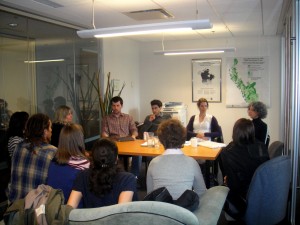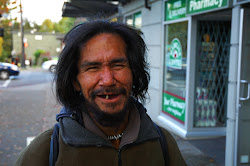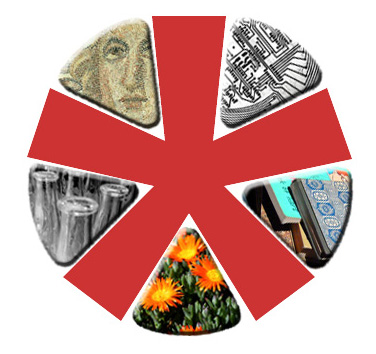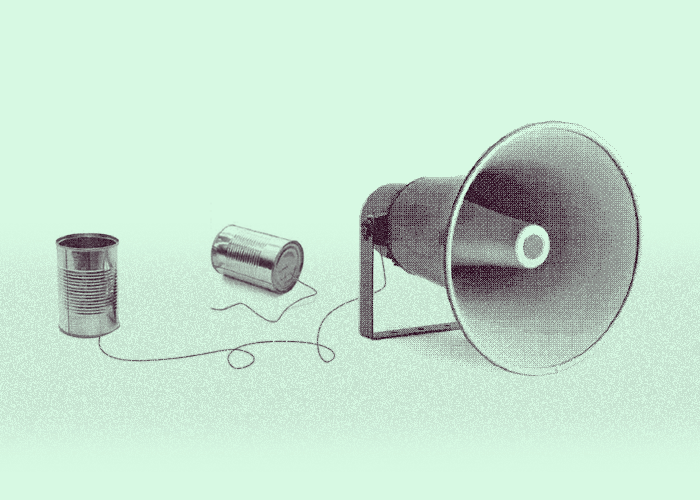Mixing It Up! Notes – CTLT Institute Session 2012
On May 30, 2012, UBC Mix teamed up with other UBC interdisciplinarians to offer the workshop “Mixing It Up! Collaborating Across the Disciplines,” part of this year’s CTLT Institute. Lead by a great group of facilitators, the session explored the benefits and challenges of interdisciplinary teaching and learning.
Panel Discussion
To get things started, a panel shared their experiences across the spectrum of interdisciplinary possibilities.
- Gordon Bates shared his experiences with Science One and highlighted its unique ability to get students thinking through multiple disciplinary lenses in the sciences.
- Christina Hendricks explained the structure of Arts One, emphasizing the rewards of working with an interdisciplinary team of instructors on a unique and thoughtful curriculum.
- Justin Ritchie explained how students and faculty can get involved in interdisciplinary thinking around issues of sustainability through UBC Reads Sustainability and the AMS Sustainability Projects Fund.
- Allen Sens discussed the genesis of ASIC 200, an innovative course co-taught by Sens (Political Science) and David Ng (Biology).
- Eugenia Yu explained how a Mix partnership between statistics and biology last year has been expanded, with advanced Statistics students offering consultation to graduate students in the School of Population and Public Health and participating in an interdisciplinary journal club.
Group Discussions
The rest of the session was dedicated to small and large group discussions to get participants sharing challenges and ideas from their various disciplinary and interdisciplinary perspectives. The facilitation team posted the six potential discussion questions:
- What are the steps for designing an interdisciplinary course from the ground up?
- How can I make my existing course more interdisciplinary?
- How does disciplinary diversity in the classroom affect our teaching practice?
- What are the challenges and benefits of interdisciplinary team teaching?
- What are the barriers and challenges that exist around interdisciplinary teaching and learning?
- Which concepts work well for interdisciplinary teaching?
Participants selected their top choices in a ‘dotmocracy‘ activity, with the most votes going to “How can I make my existing course more interdisciplinary?” and “What are the challenges and barriers around interdisciplinary teaching and learning?” Below are notes from the discussions for each question. There are also resource guides for all six questions above.
Question 1: How can I make my existing course more interdisciplinary?
Group 1
- Problem-based learning
- Pick main concepts in course
- Create problems around these (e.g. 7-8 per term)
- Students bring interdisciplinary prior knowledge in course
- Student group projects
- Put teams together from different disciplines
- Sustainability theme for project – students pick topic, but have to look at it from (2 out of) 3 perspectives:
- Environment
- Economic (if they have the data)
- Social
- They have to do research on these three perspectives
Group 2
- Using sources that are outside of classroom (plays, arts, museums + culture; issue-based)
- Guest speakers (Skype)
- Trade teaching time
- Provide provocation – challenge, process
- Create opportunities for exposure
- Release – ‘take no responsibility for the outcome’
Group 3
- Extra + co-curricular projects
- Fieldtrips
- Tutorials (subjects + content)
- Assignments
- Conversation, dialogue, collaboration
- Interprofessional curriculum
- Team teaching
- Student engagement (mixing students)
- Guest speakers
- Practice communicating knowledge
Group 4
- Having students from different departments collaborate on projects/discussions
- Invite guest speakers to lectures (with students writing reflections)
- Students working on wiki pages/online form
- Have more forward/strategic/effective planning
- Create learning goals
- Different styles of inquiry on same text/subject
Group 5
- Teaching language using interdisciplinary approaches
- Watching documentaries
- Putting people in unfamiliar situations
- Inviting other classes and people from other disciplines to speak on course topics (ask students to translate)
- Combining cultural aspects to provide context to language courses
- Letting go of content and allowing the learning objectives to be re-evaluated
- What is really relevant in the course?
- Are there aspects that aren’t necessary?
- Case studies
- Create interdisciplinary case studies through math, science, chemistry, arts
- Interactions with courses in other departments (UBC Mix!)
- Guest speakers with reflections after
- Data mash-ups
- Courses with students from varied backgrounds
- Bartering course time/time trades
Question 2: What are the challenges and barriers (and solutions!) to interdisciplinary teaching and learning?
Group 1
- How to keep the conversation sustained
- i.e. not a ‘mix for the moment’
- How to deepen and broaden the insights from different disciplinary perspectives?
- Design of course expectations that allows for a range of types of engagement
- Map out parameters
- Create specific tasks/assignments that require students from different disciplines to engage with each other to problem solve
- Use assessment as a starting point in some cases
- Joint planning
Group 2
- Language itself provides barriers – treading on others’ toes
- Scheduling
- Historical/territorial nature
- Not enough time
- Curriculum
- Preparation
- Students’ time
- Monitoring
- Marketing – convincing students it’s worthwhile
Group 3
- Teaching is private, closed
- You can teach how you want, others rarely come in and see what you’re doing
- Solutions to open up:
- Put course on the web
- Invite people to come visit your course
- Lack of expertise beyond your discipline
- Being willing to not be expert/authority
- Guest speakers
- Students do research and bring to class
- Students brainstorm how to bring disciplinary perspectives together
- If teaching in another program, need support, mentoring, dialogue with other instructors in the program
- Scheduling and logistics
- How to get two classes in one place at the same time
- Videotape and watch asynchronously
- Discussion online, or through Skype, group-conference video
Group 4
- Values, disciplinary customs, specialty, etc. at risk
- Finding collaborators
- Attend a ‘Mixer’
- Bureaucratic structure (perception, $)
- Small scale support
- Skylight
- TLEF
- UBC Mix
- Faculty sharing (teaching/T/A time)
- Control (over content, disciplinary authority)
- Conversation with others who teach from another perspective
- Re-evaluate/prioritize content in relation to learning
- Many perspectives on same subject – find them
- Time (instructor and student)
- Anxiety
- How will I understand other disciplines? (apply ‘team’ to real problem)
- Risk to GPA: build into degree requirements (Cr/P/F)
- Natural to learning – expose this – explain why this is important
Group 5
- Time
- Burning idea = motivator
- Course designer
- Support
- Sustainability fund
- TLEF $
- Expenses, staffing
- Evaluating efforts
- Demonstrating impact
- Awareness of opportunities
- Knowing who to go to/talk to
- Comfort
- Do I need to brush up on previous topics?
- Curriculum
- What if this is an existing course?
- Teaching less, learn more (learning oriented)
- Departmental/degree requirements (all, general)
- Integrated curriculum
- Department buy-in
- Scheduling
- Fitting
- Planning in advance – WAY in advance
- Organization
- Communication
- UBC Mix
- Inspiration
- Where do I get ideas around how to approach indisciplinary
- Exposure
- Resources on campus (talks, etc.)
- UBC Mix examples
- Buy in
- Make it a part of the course
- Can’t be extra-curricular
- For credit












